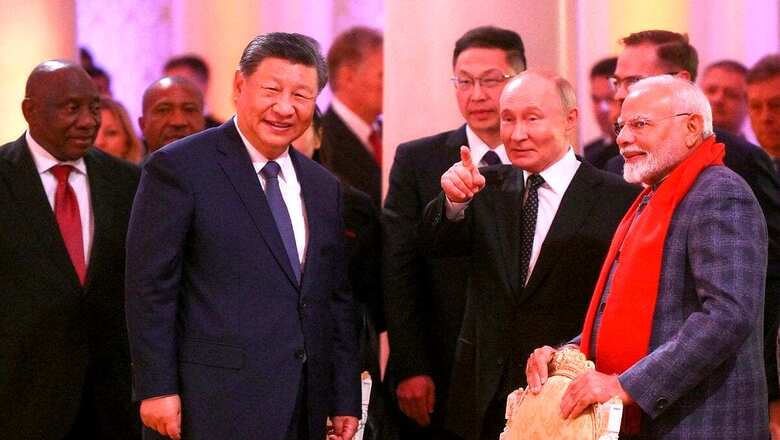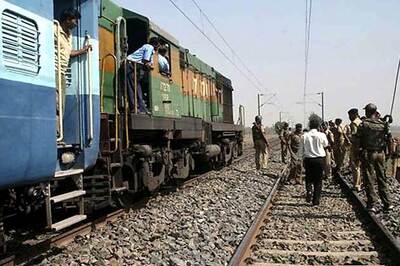
views
For starters, the BRICS has nine member countries and this is the first summit since its expansion this year. The UAE, Egypt, Ethiopia and Iran are its newest members other than South Africa and its founding members Russia, India, China and Brazil. Hosted by Russia, and with several heads of states attending including India’s PM Modi, this marks a major comeback for Putin on the world stage since the Ukraine war.
For a quick background— the BRICS started in 2009 as BRIC with its founding members Brazil, Russia, India, and China. The acronym BRIC was in fact coined by Goldman Sachs economist Jim O’Neill. He predicted that these four rapidly developing, emerging economies would eventually come to challenge the economic heft of the G7. The idea was developed in 2001, initially with foreign investment strategies in mind. By 2009, a full-scale summit took place in the Russian city of Yekaterinburg. It was attended by former Indian Prime Minister Manmohan Singh, Russia’s Dmitry Medvedev, Brazil’s Luis Inacio Da Silva and China’s Hu Jintao. In 2010, South Africa joined in, leading to the name BRICS as we know it now. Today, this grouping which once started with a focus on economic cooperation has emerged as a potentially consequential geopolitical bloc.
Despite Western scepticism, its popularity has been on the rise, leading to the addition of four new members in 2024— Egypt, Ethiopia, Iran, and the United Arab Emirates. Together, the BRICS nations form a massive global footprint. They account for 45 per cent of the world’s population, 30 per cent of the world’s landmass and 37.4 per cent of global GDP compared to the G7’s 29.3 per cent. Moreover, BRICS accounts for 25 per cent of world trade and almost 45 per cent of global oil reserves. Now that’s a formidable pool of resources, markets and economic potential. It should be noted that Argentina’s entry was also announced in 2023, but it pulled away under its new leadership, which sought to improve relations with the United States. Meanwhile, Saudi Arabia has been invited but is yet to accept.
This brings us to the important bit about this group. The BRICS has emerged as a significant counter to Western financial hegemony. It is seen as a threat to the US-led global order and primarily, the supremacy of the US dollar. Russia, especially in the context of intense Western sanctions since the Ukraine war, hopes to build institutions and systems that counter the dollar’s hegemony and pave the way for a new global reserve currency. Iran, another nation at the receiving end of the US financial sanctions, is in support of such de-dollarisation.
Putin hopes to push for greater geopolitical and ideological alignment, essentially portraying it as an anti-Western bloc. One of Russia’s biggest goals is to push for a common BRICS currency, however, Putin recently said that the time for it has not come yet. Currently, most members of the group are more interested in the use of each other’s currencies as well as digital currencies for mutual trade. Putin has also proposed the creation of a BRICS rating agency to push mutual investments and an alternative to the SWIFT payments system, which countries like Russia and Iran have been shunned out of by the dominant West.
It is also important to remember that while the BRICS may seem to be an inherently anti-Western bloc because of the presence of Russia and China, it is also fragmented in terms of viewpoints, from economic cooperation to ideological. While Russia, China and Iran may be more closely aligned on anti-Western rhetoric, players like India, the UAE and Egypt have functioning relationships with both sides with extensive trade relations. In the context of our nation, the BRICS serves India’s strategic autonomy well. As per the words of External Affairs Minister S Jaishankar, the BRICS is non-Western, not anti-Western. India also plays a considerable balancing role in the lopsided group, owing to China’s outright dominance in terms of economic heft.
Now, sceptics assert that the BRICS is doomed to be dysfunctional owing to its wide-ranging views and lack of consensus. However, this has not taken away from its appeal. More than 30 other nations are part of the summit this time and have either requested to join the group or expressed interest in doing so. This is because the BRICS has become an undeniable reality, especially with the decline of American hegemony and the rise of China. The presence of India further enhances the appeal, given the example it has set for the Global South.
Most nations wish to hedge against the West by being in the BRICS, balancing relations with both sides and keeping their options open. Further appeal comes from the hunt for counters to Western sanctions and alternatives to West-dominated financial institutions. BRICS’ New Development Bank or the NDB is emerging as a significant partner for developing nations. As of the latest available data, the NDB has approved $32.8 billion in financing for 96 projects in BRICS countries.
BRICS is, therefore, here to stay. It is the most fashionable hedging bet a Global South nation can make in this day and age in the face of Western hegemony. It has the protections of multilateralism offering a balance of power without outright Chinese or Russian dominance. And it claims to have solutions to real-world problems which may ultimately make a solid impact on the global economy in the years to come.
Views expressed in the above piece are personal and solely those of the author. They do not necessarily reflect News18’s views.

















Comments
0 comment